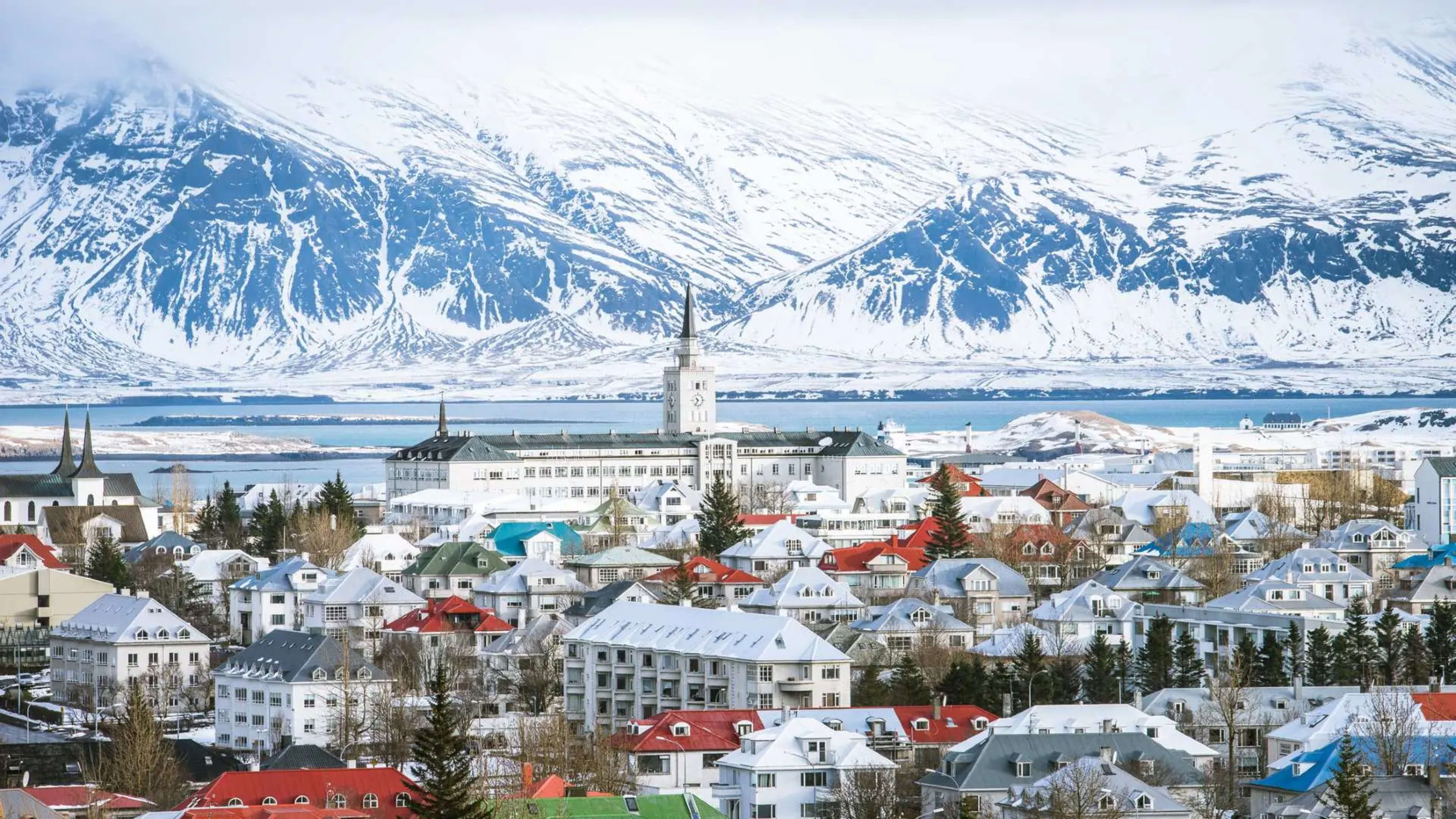Iceland is a country of great extremes. On the one hand, you’ve got sparkling glaciers and towering volcanoes, and in between, endless wonders. Whether it’s a sprawling lava field, dramatic gorge, or natural hot spring, you’ll get a taste of everything on your trip.
With so many incredible places to visit, it can be tough to know where to begin. The crème de la crème of Iceland’s landmarks wasn’t easy to choose because each part of the country offers something special.
But, after careful consideration, we’ve narrowed it down to 10 Iceland landmarks you simply can’t miss. Let’s dive into these attractions that will make your journey unforgettable.
- See Iceland’s best-loved landmarks on a guided group tour.
1. Jökulsárlón glacier lagoon (and Diamond Beach)
Jökulsárlón glacier lagoon is in a league of its own. You’ll find this natural landmark on the southeast coast of Iceland, about 6 hours from Reykjavík.

The surrounding area is dominated by the great Vatnajökull, Europe’s largest glacier. In fact, Vatnajökull’s outlet glacier, Breiðamerkurjökull, feeds the lagoon.
‘Jökulsárlón’ roughly translates to ‘glacial river lagoon’, which sums it up quite well. The lagoon is the deepest in Iceland, carved out by the river and its feeding glacier.
You’ll notice the icebergs in Jökulsárlón come in many different colors. The shade of the ice has to do with the amount of oxygen inside each block.
In summer, you can join boat tours to see them up close – an experience you won’t soon forget! During the tour, look out for seals swimming in the icy waters and Arctic terns who come to nest here.

The multicolored icebergs break off Breiðamerkurjökull to drop into the lagoon, only to keep floating until they reach the black beach below. Once they have made it to the shore, the icebergs are much smaller. This is where most spend their last moments before reuniting with the Atlantic Ocean.
The black sand beach where they melt away is known as Diamond Beach, but its real name is Fellsfjara. You’ll definitely want to stop by and admire the glittering ice decorating the shore.
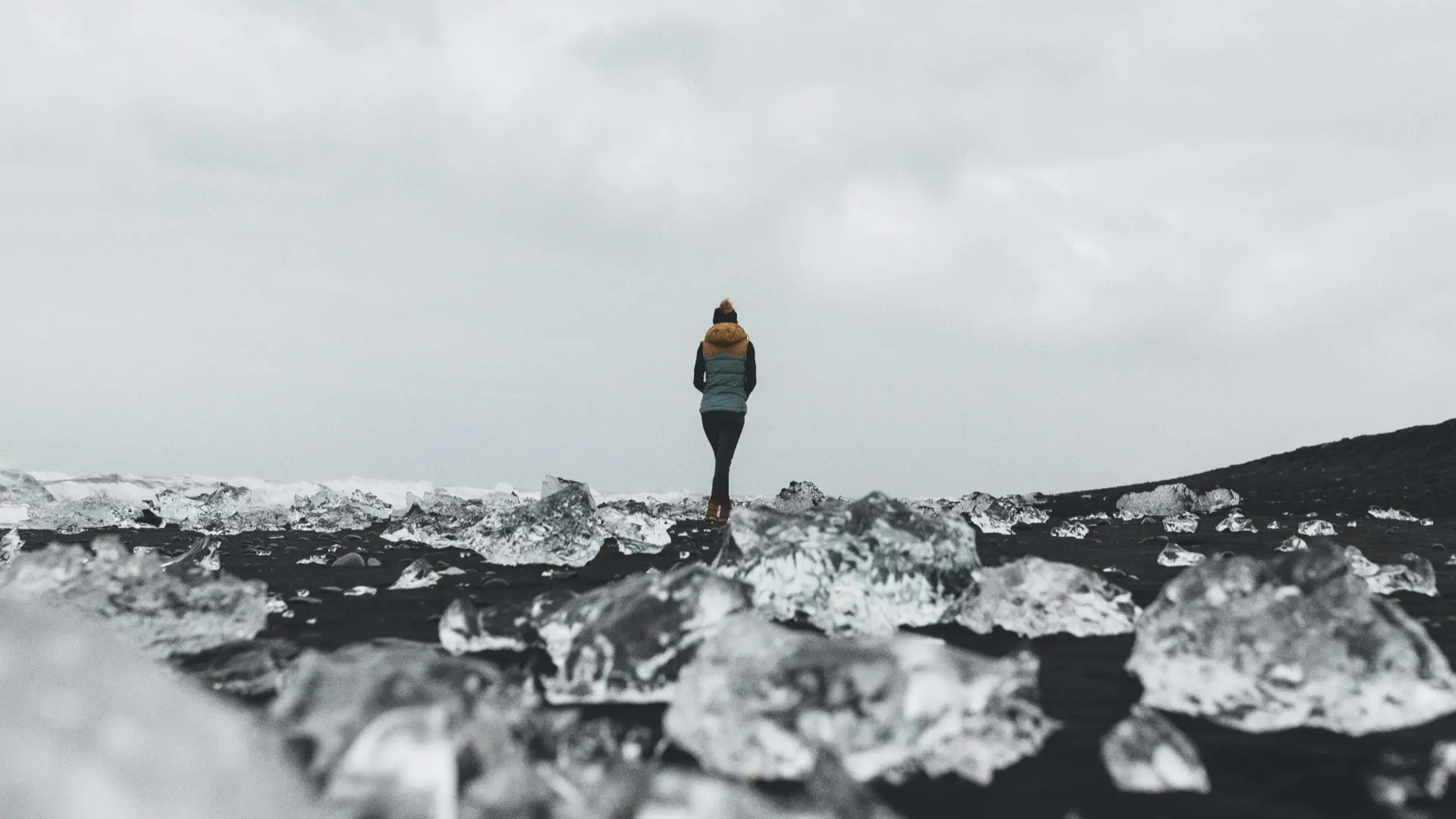
Jökulsárlón is surprisingly lively for a place surrounded by ancient ice. Sitting by the bay, watching the icebergs float by, you can’t help but feel recharged.
- Visit Jökulsárlón & other major landmarks in Iceland on a south coast tour+.
- Related: Jökulsárlón glacier lagoon in Iceland – Ultimate guide.
2. Blue Lagoon
The first thing most people think of when you mention Iceland is the Blue Lagoon. This isn’t surprising, given its incredible location, milky-blue color, and proven healing powers.
The Blue Lagoon sits in the middle of the Reykjanes peninsula between Keflavík airport and Reykjavík, making it the ideal stop on your way to or from the airport.

This world-class geothermal spa has everything you need to relax. Think built-in bar, steam cave, sauna, and even in-water massages. If you plan to stay overnight, you’ve got 2 luxurious hotels to choose from: The Retreat Hotel and Silica.
Plus, the menus at the amazing on-site restaurants – Lava, Moss, and Spa – are packed with delicious Icelandic dishes with a modern twist.
There’s no shortage of things to do at the Blue Lagoon. It’s the perfect place to recharge or get that jet lag out of your system.
- Experience the Blue Lagoon on a multi-day tour from Reykjavík.
- Related: Your ultimate guide to the Blue Lagoon in Iceland.
3. Gullfoss waterfall
Gullfoss, or ‘Golden Falls’, is a powerful 2-story waterfall in South Iceland and one of the 3 main attractions on the Golden Circle route. No matter the season, this mighty cascade is worth a visit. You’ll be amazed by the water rushing down a 90-degree drop into the valley below.
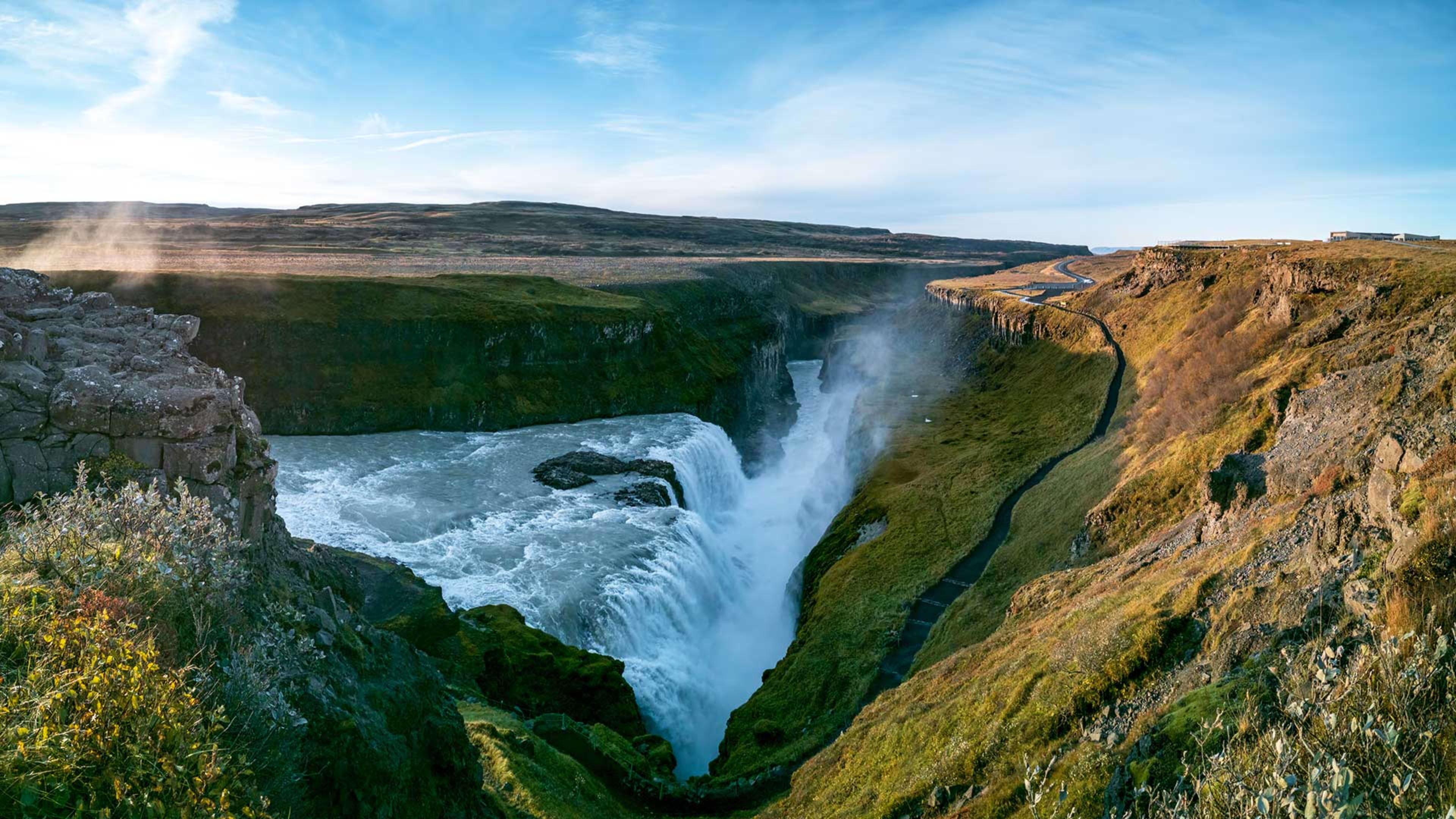
Gullfoss’ water comes from the nearby Langjökull, Iceland’s second-largest glacier. The glacier is also the source of the Hraunfossar and Barnafoss waterfalls.
The waterfall has 3 different platforms to soak up the spectacular views. We recommend visiting all of them, but just a heads up – the viewpoint closest to the falls will leave you damp!
Other must-see waterfalls in Iceland include Skógafoss and Seljalandsfoss on the south coast, the north’s Goðafoss and Dettifoss, and the Westfjords’ Dynjandi.
- Explore these waterfalls on a self-drive tour.
- Related: Your ultimate guide to glaciers in Iceland.
4. Geysir and Strokkur
Geysir is the first thing you can read about Iceland in old travel books. The spouting hot spring that could reach the tallest skyscrapers sparked a story that traveled far. It later became the namesake of all the other geysers in the world and still holds the title today.
These days Geysir no longer erupts, but you’re still in for quite a show when you visit. Geysir’s baby brother Strokkur now holds the fort, shooting hot water into the sky every 4–10 minutes. Unlike his big brother, Strokkur is very predictable.

Together with Þingvellir and Gullfoss, the trio makes up the Golden Circle, Iceland’s most popular touring route.
- Visit all 3 of these natural landmarks on a Golden Circle tour.
- Related: Your complete guide to the Golden Circle route.
5. Þingvellir National Park
Þingvellir (Thingvellir) National Park needs no introduction. This UNESCO World Heritage site is one of Iceland's most historic and visited landmarks.
Þingvellir isn’t just an area of groundbreaking history – pun intended – but also a place where the ground literally breaks. Here, the North American and Eurasian continental plates meet and slowly drift apart. If you’re feeling adventurous, you can snorkel or dive between them at Silfra fissure.

Even though Þingvellir is mainly known today for its natural beauty and geological wonders, it once played a different role. The Vikings would gather there to host Alþingi, Iceland’s first parliament.
The parliament was founded in 930, making it one of the oldest in the world. You can picture the scene when you visit: the head Viking standing tall on Lögberg rock and reciting all the laws for the crowd.

If you feel like you recognize this place, you just might! Þingvellir was one of the shooting locations for Game of Thrones, and the Almannagjá gorge is the road taken by Arya Stark and The Hound on their way to the Eyrie.
- Dive into these Iceland vacation ideas & find your perfect trip.
- Related: All about the Vikings in Iceland – Origin & facts.
6. Kirkjufell mountain
Not too far from Reykjaík, on the attraction-studded Snæfellsnes peninsula, you’ll find Kirkjufell (‘church mountain’).
With its unique pyramid-shaped peak, you won’t be surprised to learn that Kirkjufell is one of the most photographed natural landmarks in Iceland. Like a few other attractions on this list, you might have already seen it on Game of Thrones.
While the mountain is easy to spot from the road, head to the Kirkjufell and Kirkjufellsfoss waterfall viewpoint to get the best vantage point. You’ll get an epic view of the waterfall with the mountain in the background.
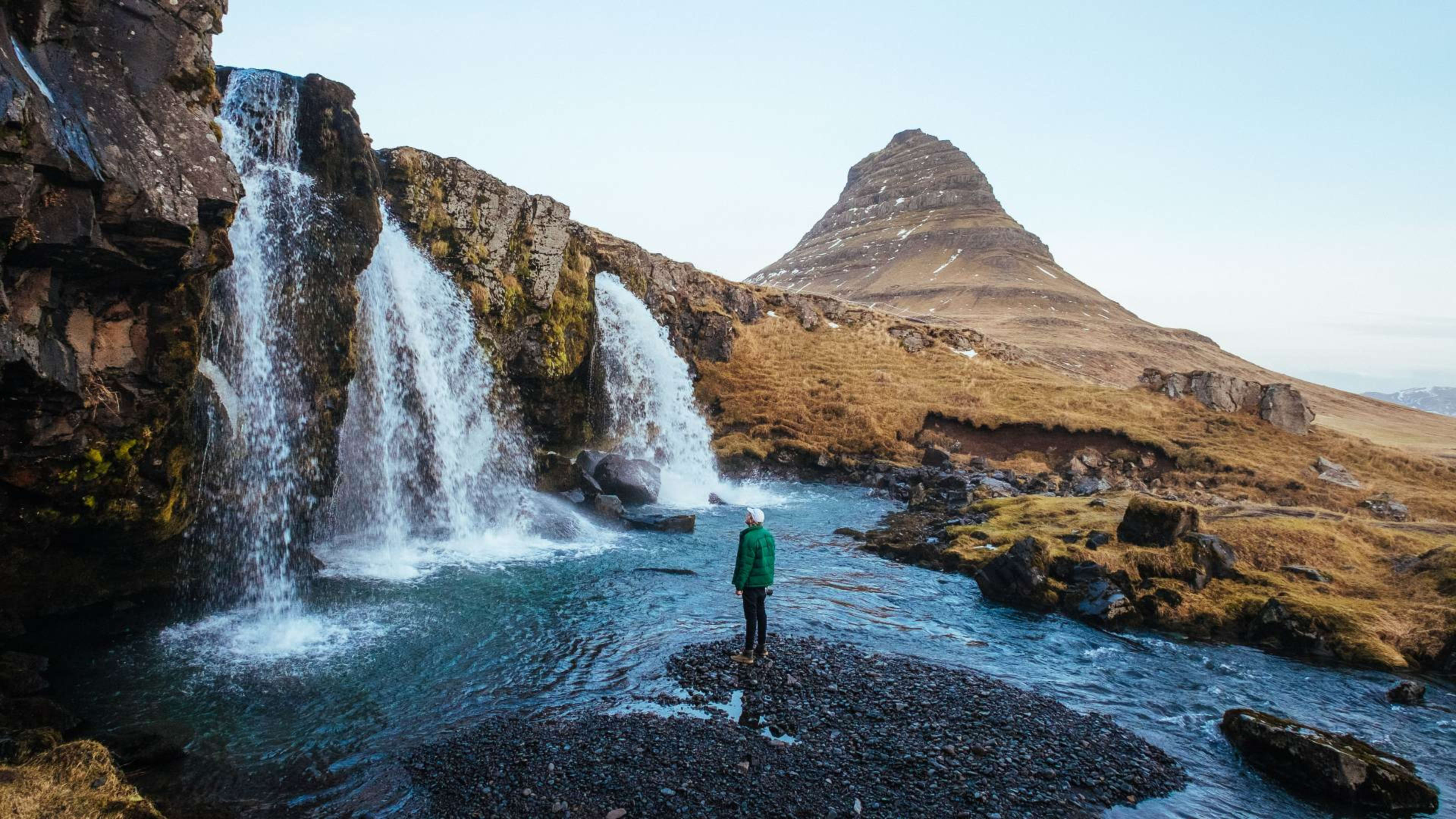
Kirkjufell is also a great lookout point for the Northern Lights in wintertime. Thanks to its remote location away from city lights, you’ll get the perfect conditions to spot the Auroras. And not to mention a truly iconic backdrop to photograph them.
- See Kirkjufell & other stunning sights on a winter tour of Iceland.
- Related: Best places to see the Northern Lights in Iceland.
7. Hallgrímskirkja church
Hallgrímskirkja is the landmark symbol of Reykjavík. You’ll notice the towering gray church stands tall above the city’s otherwise modest architecture. Around it are corrugated metal houses painted in all the colors of the rainbow, with the occasional wooden home sticking out in between.
From the top of Hallgrímskirkja tower, you’ll get panoramic views of Reykjavík’s colorful buildings, the Old Harbor, and Mount Esja. Don’t forget to bring your camera – it’s an absolute can’t-miss photo opp.

The church was designed by Guðjón Samúelsson, one of Iceland’s most famous and beloved architects. His inspiration is said to have come from Svartifoss waterfall, another landmark worth checking out.
When you compare them, it is not hard to see the inspiration. The rising pillars on each side of the church tower look exactly like the basalt rocks framing the waterfall.
Hallgrímskirkja is a Lutheran parish church and reaches 74 meters (242 feet). This makes it the tallest church in Iceland. Inside it, you can see the impressive and world-renowned pipe organ.
The organ, built by the renowned Johannes Klais of Bonn, stands an impressive 15 meters (49 feet) tall and weighs 25 metric tons.
Outside the church, you’ll find the famous Leifur Eiríksson statue. It was a gift from the United States to commemorate the 1,000-year anniversary of Alþingi, the Icelandic parliament.

The statue also honors Leifur as the first European to reach North America, highlighting Norse exploration long before Columbus. That said, it's more of a tribute than a rejection of Columbus's achievements.
Hallgrímskirkja is one of Reykjavík’s most iconic landmarks, but there’s plenty more to explore. Be sure to check out the Sun Voyager sculpture along the waterfront or the striking Harpa Concert Hall. You'll find the capital is full of must-see sights worth discovering!
- Related: Top things to do in Reykjavík.
8. Lake Mývatn
A visit to Lake Mývatn and its surrounding attractions gives you a truly surreal experience. This geological wonderland in North Iceland has been sculpted by thousands of years of volcanic eruptions, earthquakes, and other natural phenomena.
Mývatn is one of Iceland’s largest lakes and a nesting ground for dozens of bird species in summertime. Some say there’s no other place on Earth with as many different duck species.

Nearby, you’ll find volcanic craters and multicolored bubbling sulfuric hot springs. Together, they create a scene straight out of the movies. And Hollywood producers have started to take notice.
The hot springs feature in a Game of Thrones scene, where Sam is battling a foggy storm. In reality, that ‘fog’ was just the steam from the springs.
There’s lots more to see and do around Lake Mývatn. Here are a few activities to add to your itinerary:
- Take a relaxing dip in the Mývatn Nature Baths
- Explore the Martian-like landscapes of Námaskarð
- Check out Dimmuborgir’s sky-high lava formations
- See bubbling mud pools and fuming lava fields at Krafla and Leirhnjúkur
- Hike to the top of Hverfjall crater

Another incredible nearby attraction is Skútustaðagígar. Stop by to witness the biggest pseudocraters in Iceland.
- Discover this area on a tour of North Iceland & Akureyri.
- Related: Iceland in summer: Must-sees and must-dos.
9. Dettifoss
The next unmissable landmark in North Iceland is Dettifoss. This thundering set of falls claims the title of Europe’s most powerful waterfall, after Switzerland’s Rhine Falls. You’ll find it inside the Vatnajökull National Park, not too far from Lake Mývatn.
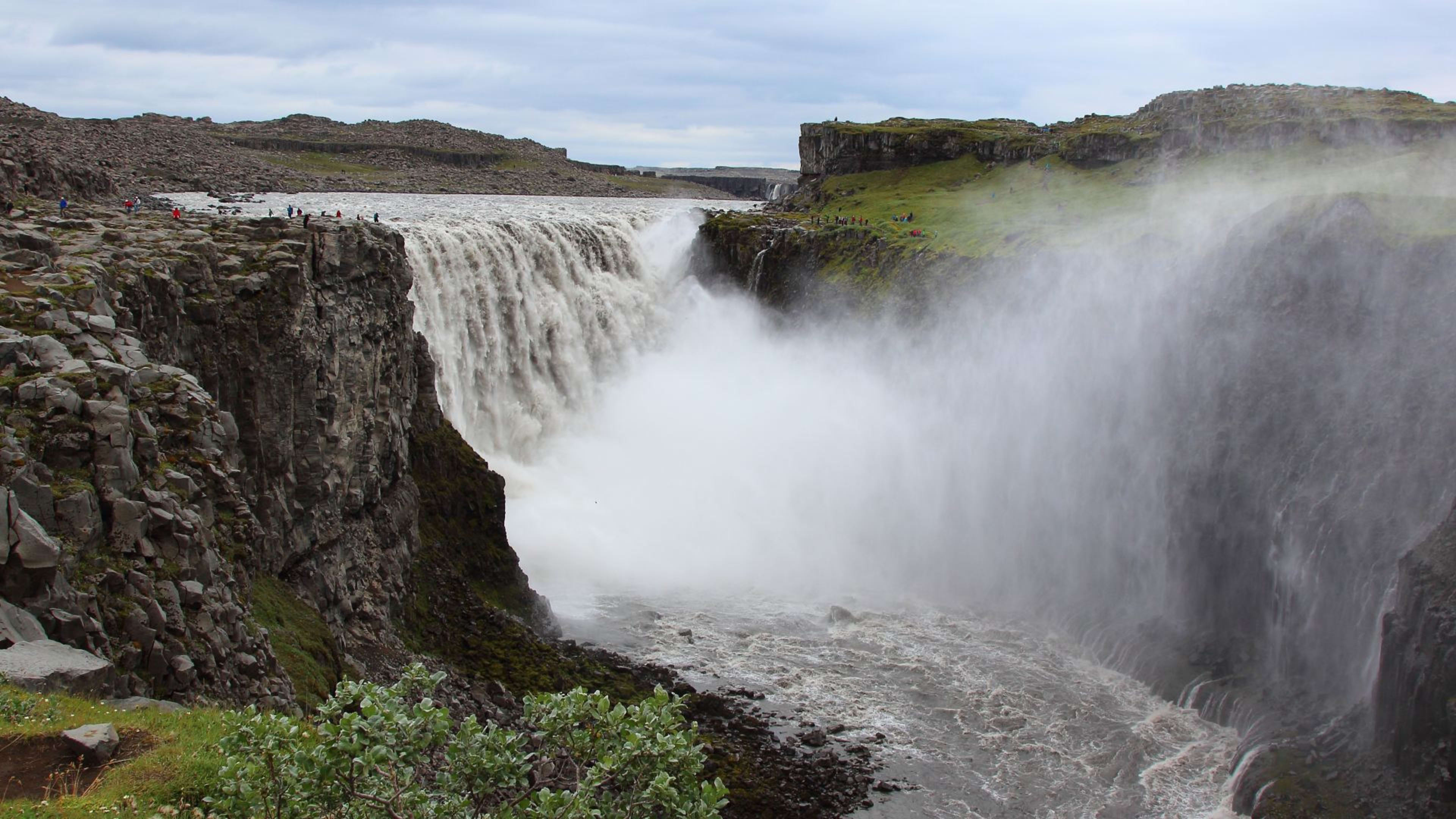
The waterfall is fed by the meltwater from the Vatnajökull glacier and spans over 100 m (330 ft) in width. You’ll be in awe of the water’s sheer force as it plummets 45 m (150 ft) down into Jökulsárgljúfur canyon.
You can reach Dettiffoss from the eastern and western sides. The east gets you closer to the action and also offers a look at the nearby Selfoss waterfall. That said, the west bank is more accessible year-round and offers a wider, panoramic view of the falls.
- Uncover the wonders of North Iceland on a private guided tour.
- Related: Awesome things to do in Iceland.
10. Fjaðrárgljúfur canyon
Fjaðrárgljúfur is one of Iceland’s most famous and awe-inspiring canyons. It was formed during the last Ice Age as glaciers melted and formed glacial rivers that carved their way through the soil. Today, the canyon plunges about 100 m (328 ft) deep and stretches 2 km (1 mi) long.
The first thing you’ll notice when you’re here is its twisting, snake-like shape and the towering walls covered in bright green moss and grass. As you go further in, you’ll hear the sound of the Fjaðrá river’s clear waters running through the ancient canyon. Many have said it’s a sight straight out of a fairytale.

Fjaðrárgljúfur used to be a bit of a hidden gem, but that changed after it appeared in Justin Bieber’s music video ‘I’ll show you’. Since then, it’s become a must-see spot in southeast Iceland.
Unfortunately, parts of the canyon have been damaged in recent years, mainly due to the rise in visitors straying from the marked paths. To help protect the landscape, make sure to stick to the trails, avoid stepping on the fragile moss, and respect any closures.
If we all do our part to travel responsibly, we can help preserve Fjaðrárgljúfur and the surrounding area for future generations.
- Witness Fjarðagljúfur in all its glory on a summer vacation in Iceland.
- Related: Best things to see & do on Iceland’s south coast.
Explore Iceland’s top landmarks with Iceland Tours
While these Icelandic landmarks are famous for a reason, there are countless other incredible attractions worth exploring when you’re visiting Iceland. You’ve got wild hot springs, ancient lava fields, and shimmering ice caves. We’ve barely scratched the surface!
One of the best ways to enjoy all of these sites is on a guided group tour. You’ll be led by a friendly local guide with in-depth knowledge of the places you’ll visit. They’ll take you to all the top attractions and hidden gems while sharing cool stories and facts about Iceland.
Plus, you’ll get to meet like-minded adventurers from all over the world.
When you’re ready to book your Icelandic adventure, our team will arrange your accommodation, transport, and any excursions. Lock in your trip today with just a 5% deposit.





